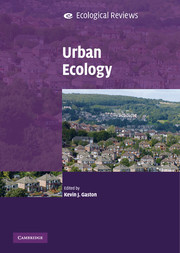Book contents
- Frontmatter
- Contents
- List of contributors
- Preface
- 1 Urban ecology
- 2 Urbanisation
- 3 Urban environments and ecosystem functions
- 4 Individual species and urbanisation
- 5 Species diversity and urbanisation: patterns, drivers and implications
- 6 Urbanisation and alien invasion
- 7 Interactions between people and nature in urban environments
- 8 Urban ecology and human social organisation
- 9 Urban ecology and human health and wellbeing
- 10 Bringing cities alive: the importance of urban green spaces for people and biodiversity
- 11 Integrating nature values in urban planning and design
- 12 Urban futures
- Index
- References
2 - Urbanisation
Published online by Cambridge University Press: 05 June 2012
- Frontmatter
- Contents
- List of contributors
- Preface
- 1 Urban ecology
- 2 Urbanisation
- 3 Urban environments and ecosystem functions
- 4 Individual species and urbanisation
- 5 Species diversity and urbanisation: patterns, drivers and implications
- 6 Urbanisation and alien invasion
- 7 Interactions between people and nature in urban environments
- 8 Urban ecology and human social organisation
- 9 Urban ecology and human health and wellbeing
- 10 Bringing cities alive: the importance of urban green spaces for people and biodiversity
- 11 Integrating nature values in urban planning and design
- 12 Urban futures
- Index
- References
Summary
Unsurprisingly, knowledge of the pattern and process of urbanisation is key background to an understanding of urban ecology. However, of course, the necessary material lies largely in other fields of study. Moreover, it is widely scattered and rather poorly synthesised. This chapter therefore provides a broad but selective overview of some of the most important issues of especial relevance to urban ecology. In particular, it addresses what constitutes an urban area, how urbanisation occurs, the history of urbanisation, the scale of urbanisation (in terms of population and household numbers, land cover and ecological footprints), the structure of urban areas (in terms of location, size, form and composition) and, finally, the sustainability of cities. Whilst an attempt has been made to draw on an extensive range of examples, there is an inevitable and unfortunate bias towards the developed regions on which the vast majority of research, and the associated literature, has been focused.
What is urban?
Urbanisation is the process by which a rural area becomes an urban one, or the degree to which an area is urbanised (although some differentiate the former process as urbanisation and the latter as urbanicity). But what is an urban area? There is no simple answer to this question, although most of us would have an intuitive sense of what constitutes such an area and what does not, probably based on the numbers of people and the level of cover by buildings, transport networks and other such infrastructure.
- Type
- Chapter
- Information
- Urban Ecology , pp. 10 - 34Publisher: Cambridge University PressPrint publication year: 2010
References
- 17
- Cited by



